#ukrainian politis
Explore tagged Tumblr posts
Text
Zelensky criticizes Brazil, G20 leaders for showing 'weak position on war'
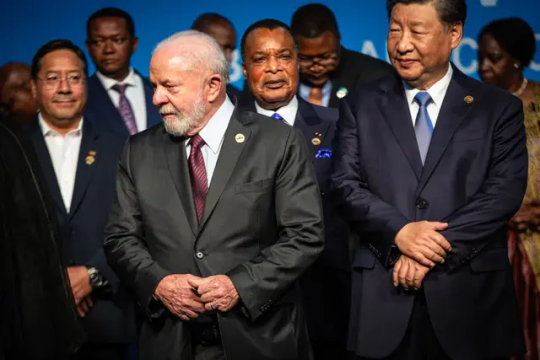
President Volodymyr Zelensky criticized Group of 20 (G20) leaders on Nov. 23 following the most recent summit in Brazil, adding that Brazilian President Lula da Silva, the current holder of the G20 Presidency, showed a "weak position" on Russia's war in Ukraine.
The group, which includes Russia among its members, also includes a number of countries who have contributed to Russia's economic development throughout its full-scale invasion of Ukraine, including China and India.
Despite ongoing divisions among G20 nations regarding the wars in Ukraine and the Middle East, negotiators managed to reach a consensus on a final communiqué that broadly condemned the human suffering caused by both wars.
The G20 summit’s final communiqué devotes just one paragraph to the war in Ukraine, a stark contrast to the seven paragraphs in last year’s declaration from New Delhi. This year’s statement omits any condemnation of nuclear threats tied to Ukraine or appeals to halt attacks on food and energy infrastructure.
Continue reading.
#brazil#politics#ukraine#russia#ukrainian politis#brazilian politics#volodymyr zelenskyy#international politics#g20#image description in alt#mod nise da silveira
2 notes
·
View notes
Text
on ethnostates and reality
in the current real world there are two options for polities
an overt ethnostate, mostly monoethnic*, with some amount of minorities that it treats variously, in large degree based on whether they have their own native ethnic state out there that cares about how they are treated / has a reputation that transfers over to them in a positive or negative manner,
a covert ethnostate, also known as "an empire", polyethnic but one of the ethnicities* is the one that dominates the echelons of power due to pre-existing accumulated wealth. Also treats its minorities differently based on whether they're immigrants from a state it respects, a state it disrespects, or don't have a state of their own (native or migrants)
*"ethnicity" is a word that stretches as far as local politics go. in the us it's 'white people', other places divisions are more gradual, it can change from generation to generation in any given place too :)
I'm sure you have noticed two curious facts about this:
there is no such thing as a non-ethnic state currently,
people's treatment, even in foreign countries & diaspora, depends on whether they have one of their own.
Jews all over the world benefit from the existence of Israel, even if they don't want to emigrate to it, and absolutely regardless of their opinion on its policies. I don't know about US politics, but in Ukraine where I live it's made an IMMENSE difference. Having a Jewish friend or relative means having a friend or relative in a first world country with better healthcare than ours! I don't even know how to explain to people who aren't already aware of this how much of a difference this makes compared to, say, the attitude towards Romani, yeah?
Jews aren't the only ones for whom ethnostate is a burning question, either. You know Ukraine? We're currently in a war that determines whether we get our own ethnostate (where our language is the state language, our culture gets promoted and sponsored, our politics are our own etc) or get eaten by a neighbouring empire - those are our two options! And the neighbouring empire is not ethnically benevolent: they say that "all Slavs are brothers" and what they mean by this is "Ukrainians aren't REALLY distinct, so it's okay to outlaw their language, destroy their culture and kidnap their children for reeducation". Our current alternative is between ETHNOSTATE and GENOCIDE.
There is a reason the current world order (at least / particularly in Europe) is mostly based around ethnostates. It used to be based around empires instead! And then empires broke apart and let their constituent parts self-govern, and this, the creation of ethnostates instead, was A MASSIVE IMPROVEMENT. Take my word for it or read some history.
One day, maybe, the world over will turn over again, and ethnostates will be replaced with another, more benevolent and equitable system. But right now, they literally have no alternative: you have an ethnostate, or you are an oppressed minority.
Let's not focus our ire for this on the political position to not get genocided ever again, yeah?
12 notes
·
View notes
Text
The Ukrainian national anthem begins with the words “Ukraine has not yet perished,” hardly an optimistic beginning for any kind of song. But this is not the only anthem whose words do not inspire optimism. The Polish national anthem starts with the familiar line “Poland has not yet perished.” The words of the Polish anthem were written in 1797 and those of the Ukrainian were penned in 1862, so it is quite clear who influenced whom. But why such pessimism? In both cases, Polish and Ukrainian, the idea of the death of the nation stemmed from the experience of the late eighteenth century – the partitions of Poland and the liquidation of the Hetmanate. Like many other anthems, the Polish one was originally a marching song written for the Polish legions fighting under the command of the future emperor of France, Napoleon Bonaparte, in his Italian campaigns. The song was originally known as the “Dąbrowski mazurka,” named for a commander of the Polish troops, Jan Henryk Dąbrowski. Many of the Polish legionnaires, including the commander himself, had taken part in the Kościuszko Uprising, and the lyrics were meant to lift their spirits after the destruction of their state by the partitioning powers. The song’s second line asserts that Poland will not perish “as long as we are alive.” By associating the nation not with the state but with those who considered themselves its members, the Polish anthem gave hope not just to the Poles but also to representatives of other stateless nations. A new generation of patriots in Poland and Ukraine refused to accept the disasters of the previous century as the final verdict of their nations. Both Polish and Ukrainian activists promoted a new understanding of a nation as a democratic polity made up of citizen patriots rather than a territorial state.
Serhii Plokhy, The Gates of Europe: A History of Ukraine
8 notes
·
View notes
Text
This must go so hard if you're an idiot
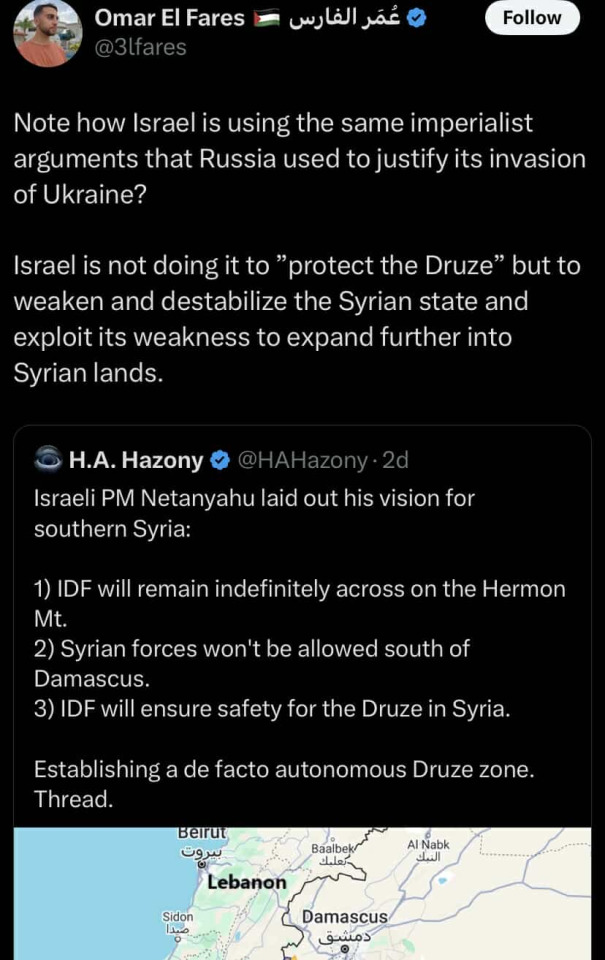
Let's break down the claims that Israel is motivated here by the same factors that motivated Russia to invade Ukraine:
1)Russia deliberately fomented disinformation that Ukraine was a "Nazi regime" targeting ethnic Russians with mass violence as a pretext for propping up separatists and later annexing the desired territories. There were far-right elements in the Donbass, but on the whole, this was just not true. Ukraine was not persecuting Russian speakers. The justification that eastern Ukraine "is majority Russian" isn't even true, the only oblast that was ever majority Russian speaking was Crimea, the rest are plurality or sizeable minority Russian speaking.
1.5)The Druze actually were targeted with mass violence by ISIS. Any part of Syria that ISIS successfully invaded was not a safe place for Druze (men). ISIS routinely would execute Druze men on the spot whenever they conquered a new town or village. Jolani is verifiably an ex-al-Qaeda and ex-ISIS member. Those who think he's based and liberalism pilled can hardly begrudge a minority who was slated for annihilation by the terror group he used to be a member of for not trusting him. Also, the Druze largely don't want to secede from Syria, but merely want autonomy. Israel is acting as a guarantor of the Druze's safety and is merely requesting that the new Syrian army not deploy south of Rif Dimashq. It's unknown what concessions Israel is willing to offer the new Syrian government in exchange for this promise. Imminent invasion seems unlikely from either party.
2)Russia's strategic aims in invading Ukraine were simple. Regime change to prevent a future EU/NATO alliance, and also secure the Crimean Peninsula and Sevastopol at all costs, including a land bridge with territory in southern Ukraine. The warm water port at Sevastopol allows the Russian navy to project power in the entire Black Sea. Additionally, the Donbass contains the majority of Ukraine's coal and other mineral wealth. Then there's the often overlooked population question, with Russia kidnapping hundreds of thousands of Ukrainian children, presumably to Russify them and stop the bleeding of its own population.
2.5) Israel's strategic aims are even more simple. We want tall mountain for looking far. Honestly Israel could just lease Mount Hermon from the Syrian government if they were willing to do that. And also having a buffer of a somewhat friendly polity would be nice too. There is no mineral wealth nor oil nor gas in this region. The IDF obviously took advantage of the chaos but likening this to the full scale invasion of Ukraine is crazy. Israel actually does seem to be genuine in its goals of propagating warm relations with the Druze in Syria, as it already has quite warm relations with the Druze in Israel, and the two nations have a quote unquote blood-pact with each other. Soft power is a good strategic goal too. Given that, how much further could Israel possibly want to "expand"?
And how is the Druze forming their own military council in the SDF style and being supported by Israel (not even monetarily) destabilizing Syria? Need I remind you that ISIS would kill practically any Druze man they found? And that Jolani, no matter your thoughts about him, was a member of that organization? This is just like how people gaslight Jews that they aren't allowed to feel unsafe with known antisemitic persons and organizations. Let the Druze decide if they feel safe in this new Syria. It seems like the answer is no. That's not propaganda, that's not the West or ZIONISTS meddling in Syria's affairs, that's a minority declaring what will keep their community safe and not waiting for permission to act on it.
And unlike the communist Russian speakers in the Donbass, the Druze's guarantor will not exaggerate their claims of oppression (because they're real) and use that as a pretext to invade their country outright and slaughter their countrymen.
So let's recap. Russia uses lies and propaganda to aggressively expand its territory in a quest to relive its glory days as an empire with total control over an ethnic group that wants nothing to do with them, and has killed and kidnapped hundreds of thousands and displaced millions. Israel uses objective fact to secure a strategic goal (that's already been accomplished), expanding its relationship with a regional minority and trying to hem in a potentially hostile regime... in the process killing like maybe 5 protesters and having an actual dialogue with the community leaders it's totally planning on violently incorporating. Russia has destroyed how many Ukrainian cities? I understand comparing the destruction in Gaza to that, but Israel's "hostile takeover of Syria" is happening pretty smoothly by comparison.
Maybe you think Israel is just cynically using the Druze as a geopolitical bargaining chip or tool or something. I still think giving them a token say and pledging to support their efforts at autonomy, even for cynical motives, is better than a full scale invasion, trying to blow up nuclear reactors, actually blowing up giant dams, massacring citizens and burying them in unmarked mass graves, sending swarms of drones to target civilian infrastructure, and threatening to use nukes, the list goes on?
Like sure, there are surface level zero nuance or knowledge about history or the region similarities between these two situations. After all a peanut butter sandwich could be mistaken for a shit sandwich, until you actually take a bite.
Is this violating Syria's sovereignty? Yes. But a) Turkey is doing that much more blatantly and not a peep from this crowd, and b) Israel has better reasons and is behaving much better than Russia vis a vis Ukraine. But to an antizionist, claiming anyone anywhere at any time has ever done something worse than Israel is blasphemy and treason of the highest order.
12 notes
·
View notes
Text
Since I had to block a bozo who defends the hate of Russian civilians, (redjaybathood), here is proof of anti-Russian sentiment towards civilians, it's not propaganda and you ain't a tankie for calling it out.
OK, so I have to respond. Firstly, my criticism doesn't mean "I think Putin's behaviour is the right thing."
Let me ask you something. Why don't you lame Chinese civilians for their government? Why don't you call them names? Their leader is also a communist who threatens other countries. Why aren't Chinese civilians considered tankies? Why don't North Korean civilians get treated like they're part of the problem? Cherry picking.
Next, you're literally doing what the OP and many other people are calling out. Hating the civilians for existing and living in a dictatorship.
And since you freaked that I didnt send the links even though you can look it up yourself (meaning you're lazy), fine. Here we go. Now let's see if you try to accuse me of lying. This is the sentiment that lead to the Japanese internment camps which everyone agrees were wrong, but I know people would cheer for Russian ones. There's a LOT of Russia-bashing, believe it or not.
And serious actual hate crimes and attacks. All called "propaganda" by bigots.
That's arson if you don't speak German.
If a foreign minister needs to call you out, it's not propaganda.
NOTE: Dubs being put on hiatus, Russian non politial products like snacks and drinks being removed or given WARNINGS in stores, none of that happens to other "evil" countries like China. Selective outrage? I'd say so. And literal paragraphs about hate from the Wiki page.
All of these are civilians who are being treated like shit on the ASSUMPTION that if you're Russian, you must hate peace. Dictators are not the people. People are brainwashed. You don't have the right to judge the peopleof a dictatorship because they aren't born evil, they're taught to obey the dictator. It happened with Hitler. It happened with Stalin. It happened with Mussolini. It happened with Pol Pot. It happened with Milosevic. It happened with Hirohito. It happens with Xi. It happens with Kim Jong Un. Why is it that when it happens with Putin, and ONLY with Putin, are the civilians suddenly just as problematic as the leader? You can't judge an entire nationality based on a select number of people you've seen who agree (or pretend to agree, as many may not actually agree but pretend. If all you view them as is cowards, but you don't hold the same values to other citizens of dictatorships, you are in fact, a BIGOT and it's not problematic or propaganda or false to say so. I made myself very clear. If you still disagree that's your problem and you are a toxic person. Jesus fucking Christ)
Tell me again how being Russian automatically makes you a bad person and how civilians aren't victims just because they are living in a corrupt country. You judge the entire population based on what fringe nationalists and some brainwashed people say. Blanket statements about an entire nationality or race are NOT okay. Peoplewho criticizes this aren't automatically pro-tyranny. Not that you care or believe that.
As a bonus, let's talk about how America and Canada (my country) used to HATE UKRAINE, and they had Ukrainian internment camps.
Your reaction to this should NOT be "I don't think Ukrainians deserve peace". BOTH RUSSIA AND UKRAINE DESERVE PEACE AND TO BE FREE FROM HATE. THE HATE GOES IN ALL DIRECTIONS. THAT'S THE REASON WAR IS A THING. PUTIN NEEDS TO STOP FIGHTING. PEOPLE NEED TO STOP JUDGING CITIZENS OF A DICTATORSHIP FOR BEING FROM A DICTATORSHIP. THE MORE RUSSIANS THAT CALL OUT PUTIN ANY WAY THEY CAN THE BETTER. ALL OF THESE STATEMENTS CAN AND SHOULD CO-EXIST AND I YOU DON'T THINK SO, YOU ARE PART OF THE PROBLEM. "BUT THEIR LEADER!" "BUT I'M UKRAINIAN" "BUT LISTEN TO WHAT PEOPLE SAY" "SHUT UP TANKIE" "ORC/RUZZIAN AREN'T SLURS THEY'RE TRUE". ARE NOT EXCUSES. The orcs and Ruzzians are Putin and his lackeys, not the people who live in said tyrant's cities. Obviously people should help Ukraine, that's absolutely fine. But people should not do or say anything the people above have said. It's pretty easy to find out of touch comments on Twitter and Quora that blanket the entire population as the same "evil commie tankie orc zombies". People calling out this stuff aren't trying to make a competition of "who has it worse" when in fact war harms EVERYONE.
That's all I can say. Don't like this? Then you should really think.
11 notes
·
View notes
Text
Republic Of Many Nations - Historical Opportunity for Central/Eastern Europe?
(This is a translation of an exhibition created with the cooperation of multiple Slovak and Polish institutions for the study of history that hanged in the corridors of University of Prešov in late 2023. Consider this an introduction to Rzeczpospolita for all my 1670 girlies. It's heavily biased in favor of Rzeczpospolita, luckily in ways that are neither subtle, nor do they detract from its informational value. I am leaving out most of the pictures and the commentary under them, as well as the quotes included - simply because I couldn't fit them into the format of a tumblr article. The notes bellow in [] brackets are mine, the rest of the text is from the exhibition itself, and the pictures, or something close to them - like the same building from a different angle - appeared on the exhibition panels as well. Commentary on the pictures is also from the exhibition.)
***
Did you know that from the end of the 14th century untill the end of the 18th century a unique republic existed in what is now Poland, Lithuania, Ukraine and Belarus, which was the biggest state in Europe and which wasn't founded by military expansion, but by a peaceful alliance of Kingdom of Poland and Grandduchy of Lithuania? This republic gradually fell to the pressure of surrounding absolutist monarchies led by the Tsardom of Muscovy [1], but its legacy persists in the ethos of civil liberties, democratic participation and diversity. Legacy of this republic has become a part of the identity of nations in the Middle/Eastern Europe, which for more than two centuries resisted Russian imperial rule and which cling to these values to this day.
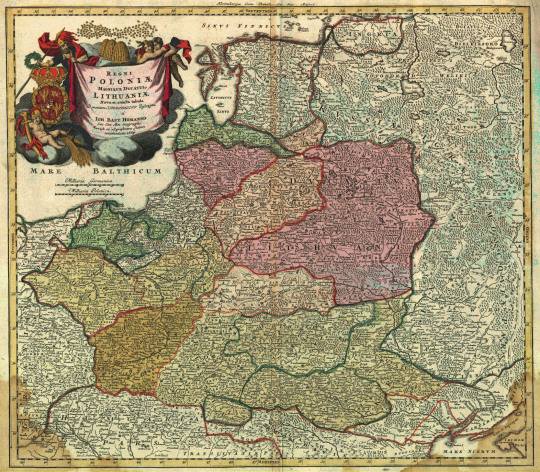
1.) REPUBLIC OF MANY NATIONS The beginings of the "republic of many nations" can be traced to the year 1385, when the hand of Jadwiga, heir to the Polish throne, was offered to Jogaila, the Grand Duke of Lithuania, with the stipulation that he should become a Christian. When Jogaila ascended the throne of Poland as Władisław II. Jagiełło, it created a dynastic link between Poland and Grandduchy of Lithuania, which besides Lithuania consisted of lands in today's Belarus and Ukraine. When on the 1st of July 1569 in the Lublin Castle Polish nobility agreed to extend their privileges to the Lithuanian nobility in exchange for Lithuania ceding large territories to the Polish crown, an agreement was born, on the basis of which a dynastic union transformed into a commonwealth, now called Rzeczpospolita, i.e. The Republic. Though initially the union of these polities was motivated by the existence of common enemies - the Teutonic Order and later Russia - the strongest bond between them turned out to be the unique arrangement established by the Polish and Lithuanian representatives. The "Republic" in the name of this polity was supposed to demonstrate that the Commonwealth would be ruled by its noble citizens regardless of whether their mother tongue was Polish, Lithuanian or Ruthenian (common ancestor of Rusyn, Belarussian and Ukrainian). Though Republic was for hundreds of years plagued by numerous internal issues, and by the end of the 18th century it was destroyed by the aggression of its neighbours, in 1791 citizens managed to approve a unique document - Constitution of 3 May 1791, now considered the first modern constitution in Europe...
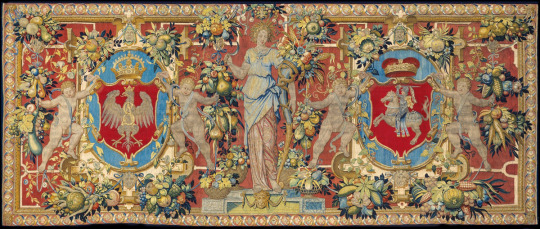
2.) STORY OF THE CROWN AND THE GRANDDUCHY Even after the Union of Lublin, the Polish Crown and Grandduchy of Lithuania were still separate states, just like they used to be for hundreds of years before that. After all, the rulers of Poland had their own archbishopric and royal title since the early 11th century, struggling for power against the likes of Přemyslids, while the grand dukes of Lithuania, attempting to revive the legacy of Kievan Rus', still hesitated whether to accept baptism from Rome or Constantinople. While many of the differences between them disappeared after the creation of Polish-Lithuanian Commonwealth, as the Lithuanian estates adopted the lifestyles of Polish nobility, the grandduchy continued to have their own legislature in the form of so-called Lithuanian Statutes, as well as their own army and finance, and a strong sense of self-determination. However, the connection between Lithuanian and Polish society was very strong - in October 1791, shortly before the final occupation of the Republic by the Prussians, Russians and Austrians both Polish and Lithuanian representatives agreed upon The Mutual Vow Of Both Nations [2], in which they promised that the story of Rzeczpospolita should continue in perpetuity as an indelible federation of the two countries...
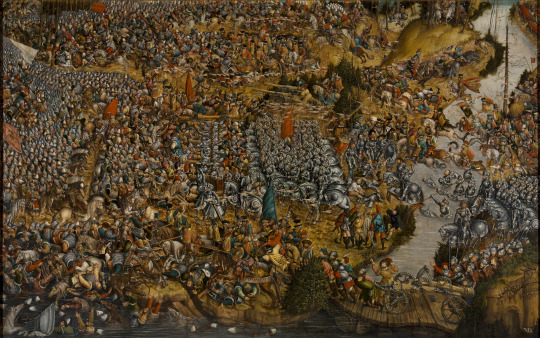
3.) THE STORY OF UKRAINE: A MISSED OPPORTUNITY FOR THE REPULIC? While its name points to a country "somewhere on the edge", Ukraine was a tempting target for many powers since the Middle Ages. After the fall of Mongolian Golden Horde in the 14th century, it was, as the former core of Kievan Rus' added to Lithuania, which presented itself as a continuation of this great Kievan empire. In this way, Lithuania came into the crosshairs of Muscovy, which held similar aspirations. After 1569 the Commonwealth of Poland-Lithuania, which in many ways respected the distinct Ukrainian identity and unlike Moscow didn't consider it to be just a branch of the Russian nation, became its protector from the Muscovite incursion into Ukraine. Even the Polish-Lithuanian nobility living in Ukraine identified and called themselves "Ruthenians", and Grand Duchy of Lithuania used so-called Ruthenian as its official language. Cossacks living in the Wild Fields in the Dnipro river basin, who on the one hand didn't accept the autority of Polish-Lithuanian nobility, on the other hand helped to safeguard the borders of Rzeczpospolita from Moscow and the Ottomans, were also bearers of the sovereign Ukrainian identity. In the middle of the 17th century dissatisfaction of the Cossacks with certain magnates and issues of religion grew into the bloody uprising of hetman Bohdan Khmelnytsky, who in 1654 turned to the Muscovite tsar [1] with a plea for protection. However, among the Cossacks, critical voices towards Moscow could also be heard, especially the voice of Ivan Vyhovsky, who in 1658 made a deal with the Commonwealth of Poland-Lithuania about its transformation into the Republic of Three Nations with a coequal position of the Grand Duchy of Russia [3] and orthodoxy. Because of the opposition from a portion of nobility, Cossacks and Moscow, the agreement never went into effect, and thus both the Republic and Ukraine missed their historic chance...
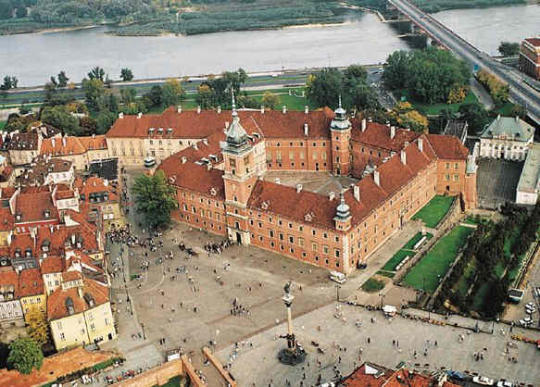
4.) KING IS THE FIRST AMONG US, THE FIRST AMONG EQUALS The creation of Polish-Lithuanian Commonwealth was also a key flashpoint for the transformation of royal power. Since Polish king Sigismund II. August, who thanks to the Union of Lublin became the ruler of Rzeczpospolita, died in 1572 without issue, Polish-Lithuanian nobility in accordance with the original agreement established the viritim election principle, according to which every noble present could elect their own king on special convocational sejms (diets). Ruler elected in this manner had to confirm noble privileges trough the so-called Henrician Articles and a collection of vows Pacta Conventa. Ruler's political power was thus perpetually subject to the rule of law (lex regnat non rex), and if the nobility deemed the ruler's actions unlawful, they could in the case of an emergency even call up a confederation and declare armed resistance. Thus, from then on until the acceptance of Constitution of 3 May 1791, the election of Polish-Lithuanian monarch became subject to the interests of foreign dynasties and local magnate houses. In the 18th century, an era during which the surrounding countries mostly adopted absolutism, the weakness of royal power came to be seen as the fundamental reason for the political decline of the Republic.
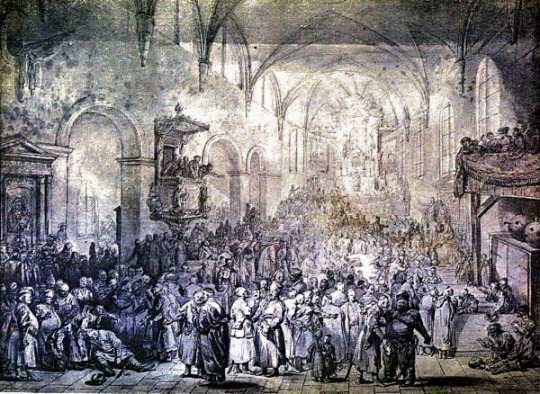
5.) NOT A MONARCHY, NOR AN ARISTOCRACY, NOR A DEMOCRACY The name Rzeczpospolita (the Republic) wasn't chosen for the Commonwealth of Poland-Lithuania by accident. Polish-Lithuanian nobility actually believed that their country can revive the lost ancient legacy of the just polities, and so they considered their Rzeczpospolita, to which they had given the epithet "most serene" [2], to be the third real republic in human history (after the Roman and Venetian ones). Members of the Polish nobility, who were convinced that the noble station brings with itself the duty of civic virtues, thus positioned themselves as the new Aristotles, and considered the so-called mixed constitution, which combined virtues of the monarchy, aristocracy and rule of the people, to be the best way to organize the state. Power in Rzeczpospolita was thus divided between the elected king, the Senate consisting of highest state officials, and a chamber of noble-born representatives, who could use the later infamous liberum veto [4], or the right of individual protest, which especially in the 18th century severely hampered the flexibility of the Republic. However, in the Republic, a specific form of political decisionmaking wasn't practiced only by the parliament of nobles. In Ukraine, the Zaporozhian Cossacks created a very peculiar form of military democracy. In their fortified camps (sietches [2]) the sietch councils formed by direct election, and they in turn elected their military commanders (atamans) and government officials, made decisions about war and piece, economic policy, even legal judgements.
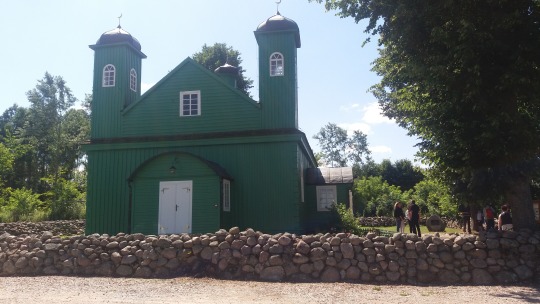
6.) DIFFERENT FAITHS LIVE TOGETHER WITHOUT NEED FOR BORDERS Calling the ancient Republic "Polish" might be misleading, because today the epithet "Polish" is tied mostly to the ethnic nation. However, since in the Polish-Lithuanian Commonwealth, the nation was the nobility, which based its honour on citizen loyalty towards the common polity inspired by antiquity, the noble "nation" at the time included all members of the class no matter the country they were born in, language they spoke, or the faith they professed. That's why, concerning the question of self-perception in the period, we often see the phrase "I am of the Polish nation, but of Ruthenian birth." This citizenship-based definition of Polish identity was closely related to the unprecedented religious tolerance, as codified in 1573 by the so-called Warsaw Confederation. The fact that the noble "nation" included not only Catholics, Lutherans, Calvinists, Uniates and Orthodox Christians, but Mennonites and Arians, led to Rzeczpospolita being called "a state without stacks", because the foreigners there didn't end up burned at a stake, but finding a refuge. However, in the 18th century, this fragile coexistence of different denominations was severely disturbed, because the neighbouring great powers loved to use the rights of religious minorities for their own ends. In the 3 May 1791 constitution, all faiths were thus tolerated, but the Catholicism was supposed to be the state religion.
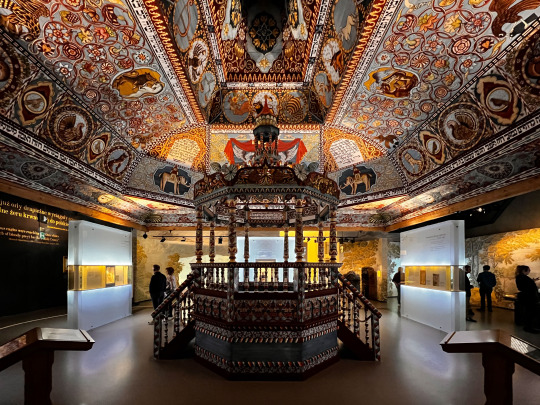
7.) POLONIA PARADISUS JUDAEORUM While the Jewish people were often banished from the rest of medieval European countries, kings of Poland granted many privileges to the arriving Jews. That being not just The Great Charter of Jewish Rights [2] from 1264, but also Privilegia de non tolerandis Christianis, which allowed Jewish merchants to settle in designated communities without Christian competition. Jews gradually gained the right to their own local administration (so-called kahalas) and around the time of the Union of Lublin even to summon their own parliament, called the Diet of the Four Countries [2] (also known as Va'ad). It is therefore no wonder that in the 16th century Europeans started to call Rzeczpospolita "Jewish paradise" and that three quarters of the entire Jewish population of the world lived here. This peaceful coexistence started to suffer in the middle of the 17th century, mainly because of Cossack uprisings, during which thousands of Jews were massacred for being alleged allies of the nobility, while in the 18th century the country experienced general decline in religious tolerance. However, as part of the attempt to save the Republic during the so-called Great Sejm [2] of 1788-1792, a special commission was created to designate the position of Jews within Rzeczpospolita. And when the famous Kościusko uprising defending the independence of Rzeczpospolita and the legacy of the Constitution of 3 May 1791 against the Russian invasion broke out, many Jews didn't hesitate to join the first Jewish regiment and fight in battle for the Republic.
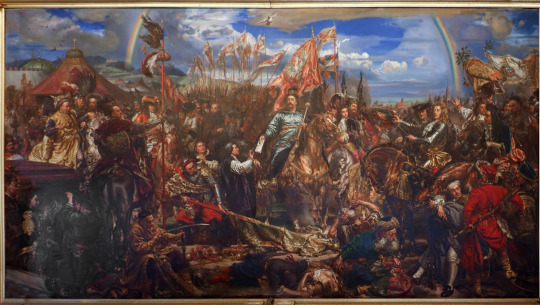
8.) WALLS OF CHRISTIAN EUROPE Noble citizens didn't perceive their Republic as just an embodiment of ancient community, but also a military power. That's why the nobility placed so much value on military virtues and in emulation of ancient Sarmatians, whose descendants they considered themselves to be, they also relied heavily on elite cavalry - the winged hussars, whose exotic appearance and military prowess gained them respect on the battlefield. Polish-Lithuanian nobility, convinced of the exceptional nature of their own Republic, started to perceive their polity as "antemurale christianitatis" - the bastion of Christendom, which protects the eastern borders of Europe from the outside threat. In the 1621 battle of Khotyn the united Polish-Lithuanian army, boosted by thousands of Cossacks led by the hetman of Zaporizhzhia Sahaidachny, a great promoter of cooperation between the Cossacks and Poland-Lithuania, managed to hold back the Ottoman army several times its size. The Polish society connected several such victories to the Divine providence and a faith that the Republic is fulfilling its holy mission in history. This is also the reason why the hussars of king Jan III. Sobieski are to this day considered the saviours of Vienna from the Ottoman siege of 1683 and the madona of Czenstochowa is perceived as the one responsible for the Polish-Lithuanian victory over the Swedes. Though the military glory of the former empire had declined in the 18th century, the enlightenment era reformers didn't forget the valor of their ancestors - the School of Chivalry was established on the prompting of king Stanislaw August Poniatowsky, and among its absolvents was Tadeusz Kościuszko, born in the Duchy of Lithuania, leader of the last stand of the Republic against Russia in 1794.
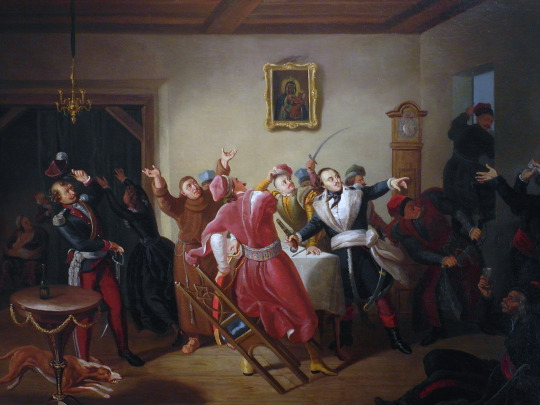
9.) NOTHING ABOUT US WITHOUT US While the king od France could've said "I am the state", in the Polish-Lithuanian Union the state were its citizens, that being the nobility. Nobility's agitation for their privileges gradually bore fruit - particularly important were the neminem captivabimus privilege, ensuring untouchability of a person, and the nihil novi rule, forbidding the king from issuing laws without the approval of a diet of nobles. Power of the nobility was among other things ensured by the size of this estate, since it made up 8-10% of the population (for comparison, in Great Britain, even in the mid-19th century only 6% of the population had a right to vote). In comparison with other countries, all members of the nobility were absolute equals in the eyes of the law. All of these rules were supported by the specific ideology of sarmatism, according to which were all noblemen, as the alleged descendants of the ancient ethnic group, required to protect the so-called "golden liberties" - set of rights and values which made the Polish-Lithuanian nobility consider themselves the most free nation under the the sun. Besides the exotic clothing [5], sarmatism was also expressed in numerous acts of rebellion against their own king - for example, in the 18th century nobility founded the Bar Confederation, which was supposed to rid the Commonwealth of the Russian influence, but ended up leading to the first division of Rzeczpospolita lands among the imperial powers.
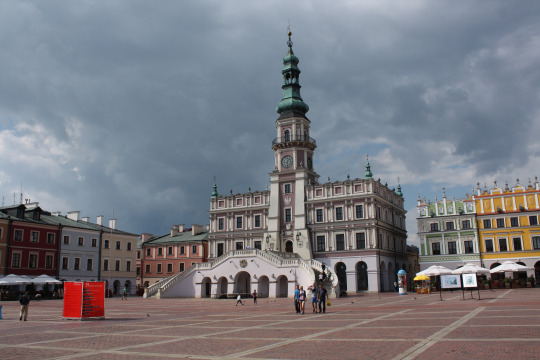
10.) SPLENDOR AND MISERY OF THE MAGNATE FAMILIES Though in the Commonwealth, any use of titles that would distinguish between lower and higher nobility was strictly forbidden, the issue was nonetheless made more complicated by the high economic inequality even among the nobles. Some noble houses were able to create estates so large even the royal holdings paled in comparison. Their dominance rested on their large wealth, high positions in state offices and background influence on politics. This informal class of magnates was most prominent in the eastern part of the country, where a handful of houses amassed giant private armies and sophisticated webs of noble clients, since many of the impoverished nobles voluntarily worked for the magnates, and some even voted in the parliament according to the wishes of their benefactors. These most powerful magnates were thus also titled "little kings", and some of them actually did become elected kings of Poland. The fact that many magnates, especially in Ukraine, were out of the reach of central state power and treated their subjects especially badly led to the outbreak of antimagnate rebellions, the most successful of which was the Bohdan Khmelnytsky Cossack uprising of 1648. However, the magnate activity cannot be seen as black-and-white, because their role also involved foundation and patronage on a grand scale - it was thanks to them that many treasures of Polish-Lithuanian architecture were created.
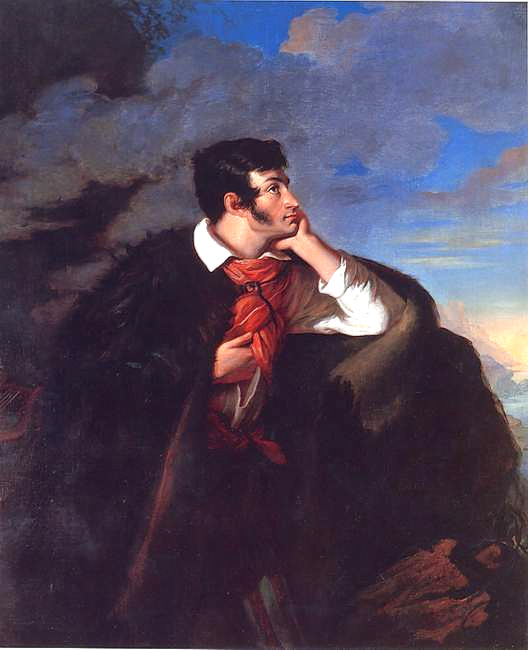
11.) LEGACY OF THE REPUBLIC OF MANY NATIONS The Republic of Poland-Lithuania was erased from the map in 1795. However, its tradition remained in the ethos of fight "for freedom yours and ours", which was echoed by the participants of many antirussian uprisings in the 19th and 20th century. This ethos called back to the tradition of free republic, which, unlike the Russian Empire - that forced subjugated polities to adopt the samoderzhavie [6], orthodoxy and russification triad - supposedly enabled different nations to keep their freedom and "unity in diversity". Although the ethnonationalism of the 20th century has dimmed the memories of their common legacy and caused plenty of bad blood among the different nations of former Rzeczpospolita, the idea of confederation or close cooperation against Russian imperialism was returning in their consciousness, whether during the 1863 uprising or shortly after World War I. In the communist era, the writer in exile Jerzy Giedroyc famously prophesized that Poland can be truly free only when so are Lithuania, Belarus and Ukraine. For Ukrainians and Belarussians, who have been threatened by the imperial idea of Greater Russia and the vision of a unified "Russian world" even after 1991, are heroes (like prince Konstanty Ostrogski or hetman Sahaidachny) and famous moments in the history of the Republic fundamental symbols of their national sovereignty and belonging to the European civilizational space. They will never cease to remind everyone that the Republic is not dead while we are alive and believe that the ties of mutual civic loyalty are stronger than differences in language, faith or ethnic origin, stronger than any enemy that would attempt to tear these ties of our values.
***
[1] - Russia. They are talking about Russia. Y'see, the etymology of "Russian" in Eastern Slavic languages is kinda confusing; originally, it meant all Eastern Slavs, but later on it came to be associated with the largest and most culturally dominant group - which is to say the predecessors of modern Russians under the rule of Princedom of Muscovy. Eventually, Ivan IV., the Grand Prince of Muscovy got himself crown the Tsar of All Russians, which was a bit presumptuous considering a whole lot of people who very much weren't under his rule also identified as the Rus'/Russians. Still, it stuck, and when Ukrainians and Belarussians wanted to define themselves against their Russian overlords, they abandoned the label "Russians" altogether. Calling post-Ivan the Terrible Russians "Muscovites" is a bit of antiquated terminology that would be common in Polish-Lithuanian Commonwealth.
[2] - Literal translation, because I don't know what it's called in English-speaking historical literature.
[3] - Used here in the older sense of the word, i.e. Eastern Slavic in general (see [1]). In this case, the Eastern Slavs in question are clearly mostly Ukrainians despite being called Rus'/Russians (YES I KNOW)
[4] - Okay, so have you seen the first episode? The whole "One of us was against. End of story. We have a democracy." thing was... Barely an exaggeration to be honest.
[5] - Compare the shit Jan Paweł and his friends wear to normal 17th century male clothing (to which Ciesław and especially magnate's son come pretty close to) and you'll get the gist.
[6] - rus. autocracy, or rather the name for specific absolutist tradition of Russian tzars
***
Notes on the pictures:
1.) Map of Rzeczpospolita from the first half of the 18th century (most likely around 1739), made by the cartographer Johann Baptist Homann.
2.) Tapestry with the coats-of-arms of Poland and Lithuania - The Union of Lublin led among other things to the joining of Polish and Lithuanian coats-of-arms, so the new state coats-of-arms combined the polish royal eagle on red field with the traditional symbol of Lithuania, the Pogoń (Vytis in Lithuanian), or the armored knight on a horse, which to this day is part of the legacy of the Grandduchy in modern Lithuanian and parts of Belarussian society.
3.) Battle of Orsha (1514) in which the orthodox prince Konstanty Ostrogski, claiming to carry on the legacy of the Kievan Rus', led the united Polish-Lithuanian forces and destroyed the Muscovite invasion army despite being outnumbered, saving the independence of the Grandduchy. After 1991 the day of the anniversary of this battle was celebrated as a holiday of the Belarussian army. The holiday was later abolished by the Lukashenko regime, one can currently end up in jail for celebrating it. In 2017, a common Lithuanian-Polish-Ukrainian brigade was named hetman Ostrogski.
4.) Royal Castle in Warsaw - Since the late 16th century, Warsaw became the new center of power in the Republic. The Royal Castle, originally the medieval seat of the dukes of Massovia, was rebuilt in the new baroque style. During World War II, the castle was completely destroyed. For a long time, the communist regime was refusing to greenlight its reconstruction, and its restoration based on old engravings and pre-war photographs was only made possible trough the massive public pressure.
5.) Painting of the French artist Jean-Pierre Norblin portrays a traditional part of the political life in Rzeczpospolita - a session of the so-called sejmik (Polish diminutive of sejm, a.k.a. diet). On these local assemblies of nobles of the given region, deputies for the meetings of the central sejm were elected and instructions for these deputies were agreed upon.
6.) Kruszyniany - Presence of the muslim Tartar community is part of the legacy of Rzeczpospolita. Tartars live on the territories of today's Lithuania, Belarus and Poland continuously since the 14th century. They have proven their worth as warriors in service of the Republic. Original Tartar mosques can be found especially in Podlesie in today's northeastern Poland and in Trakai in today's Lithuania.
7.) Ceiling of a synagogue reconstructed for the POLIN Museum of the History of Polish Jews in Warsaw, which in 2015 was awarded the title of Best Museum in Europe. It is in this modern museum that you can learn the most about the Jews of Rzeczpospolita, the largest Jewish diaspora at the time.
8.) Sobieski at Vienna - Painting of Jan Matejko depicts the Polish king Jan III. Sobieski, who after his famous triumph over the Ottoman Turks in 1683 sent a letter to pope Innocent IX., in which he writes that the Christian Vienna was saved.
9.) Casimir Pulaski, later national hero of the United States, escaped Poland after the failure of the Bar Confederation in 1769-1772. The confederation was one of the last attempts to free the country from the increasing dependency on Russia.
10.) Zamoćś - Renessaince city founded by an exceptional person. Jan Zamoyski came from a not very wealthy noble family, but trough his own merits eventually became the richest and most powerful man in the Republic. The town hall of Zamość on the photo.
11.) Adam Mickiewicz could be the symbol of the common legacy of Rzeczpospolita. The greatest poet in the Polish language literature was born in today's Belarus (1798) and always felt like a citizen of Rzeczpospolita. His most important work begins with a line "Lithuania, my fatherland!" It was Mickiewicz who was remembered by the pope John Paul II., when he proclaimed the Polish-Lithuanian Commonwealth the predecessor of cooperation of the entire continent within the European Union ("from the Union of Lublin to the European Union").
12 notes
·
View notes
Note
I can't fully remember if it was you that recommended this, but I think it was so here it is - thank your for recommending Timothy Snyder Making Of Modern Ukraine! I always wanted to learn more about eastern European history but didn't know where to start, and his class is really nice :-) thank you!
You're in luck, that was me! I know that @chessna2 has read one of his other books and recommends it, just as i rec what i think of as the companiom book to those lectures, which is "the reconstruction of nations". He's a very good professor, and for anyone else who might want to be educated on the centuries of history in the area:
6 notes
·
View notes
Text
Anthony King, Urban Warfare in the Twenty-First Century - Polity, 2nd edition, May 2025
Anthony King, Urban Warfare in the Twenty-First Century – Polity, 2nd edition, May 2025 War is urbanising. From Mosul to Mumbai, Aleppo to Marawi, the largest and most intense battles of the twenty-first century have taken place in densely populated urban areas. In the Ukraine War, Russian and Ukrainian troops have converged on urban areas, Kyiv, Mariupol, and Bakhmut, to fight brutal…

View On WordPress
0 notes
Text
The Making of Modern Ukraine | Coursera
0 notes
Text
News Roundup 12/13/2023 | The Libertarian Institute
Here is your daily roundup of today's news:
News Roundup 12/13/2023
by Kyle Anzalone
US News
Jack Teixeira’s Commanding Officer Removed from Post. GuardianThe Institute
Venezuela Says US Military Drills in Guyana Are “Provocation.” AFP
Russia
Russian Oil Revenue Higher in October Than in Year Before War. Bloomberg The Institute
Zelensky: “You Can Count on Ukraine and We Hope to Be Able to Count on You” NBCAWC
As the Biden administration is seeking over $60 billion to fund the war in Ukraine for another year, a poll has found that nearly half of American voters think the US is spending too much on the conflict. AWC
Ukrainian Foreign Minister Offers to Jump and Dance for EU Membership. AP
Republicans Appear Unmoved on Ukraine Aid After Meeting with Zelensky. TIMEAWC
After Ukraine’s failed counteroffensive, US and Ukrainian officials are looking for a new strategy for the war against Russia as political leadership in both nations is determined to keep the conflict going. AWC
Zelensky meets with the leaders of American arms makers. X
Secretary of State Antony Blinken announced the US has put 250 individuals and entities on blacklists for supporting the Russian invasion of Ukraine. Washington has waged an economic war aimed at destroying the Russian economy for the past 20 months. However, Moscow has largely successfully circumvented the Western financial penalties. The Institute
China
Chinese and Philippine vessels collided near a disputed reef in the South China Sea as tensions in the waters continue to rise. AWC
The US Sanctions Two Chinese Officials for “Serious Human Rights Abuses” Against the Uyghurs. RFA
Israel
Destruction of Gaza Compared to Years-Long WWII Bombing Campaigns. FT
US Officials Say Hostage Release Talks Breakdown. Politico
Israel Pushes Palestinians into “Safe Zones” with no Aid, Bathrooms or Running Water. AP
Haaretz Editorial Board Warns “Israeli Jails Must Not Become Execution Facilities.” Haaretz
Blinken Says What Happens to Gaza After Israeli Military Campaign Is Tel Aviv’s Decision to Make. Politico
UN Official Says Israel Trying to Push Gazans Into Egypt. NYT
Israeli Prime Minister Benjamin Netanyahu on Saturday said he appreciated the US vetoing a UN Security Council resolution that called for an immediate ceasefire in Gaza and vowed to continue his war in the besieged enclave, which has killed at least 18,000 Palestinians. AWC
The Biden administration is bypassing Congress to get 13,000 rounds of tank ammunition to Israel to fuel its onslaught in Gaza by waiving a congressional review period for foreign weapons sales. AWC
Haaretz: Data Shows Israeli Bombing in Gaza Less Restrained Than Past Operations. Haaretz
Israeli National Security Advisor Tzachi Hanegbi said on Saturday that Israel was ready to act against the Houthis in Yemen if the US and its allies do not. AWC
5,000 Israeli Soldiers Injured Fighting in Gaza. MEE
WHO Warns Gaza’s Health System “On Its Knees.” WashPo
Death Toll in Gaza Crosses 18,000 with 300 Killed in 24 Hours. AJ
Israel Prepared to Fight for Months or Longer to Defeat Hamas. APAWC
Israeli Army Accused of Arbitrary Detention of Women and Children in Gaza. MEE
Josep Borrell, the European Union’s top foreign policy official, said Monday that the destruction in Gaza as a result of the Israeli bombing campaign could be “even greater” than the damage to German cities during World War II, AFP reported. AWC
Biden Says Israel Government “Doesn’t Want a Two-State Solution.” FT
The UN General Assembly on Tuesday voted overwhelmingly to adopt a resolution demanding a ceasefire in Gaza as global opposition to the US-backed Israeli massacre of Palestinians continues to rise. AWC
Lebanon
Israel used US-provided white phosphorous munitions in an attack on southern Lebanon that wounded nine civilians, The Washington Post reported on Monday. AWC
White House Says It Is “Concerned” About Reports Israel Used White Phosphorous in Lebanon. Politico
Israeli Shell Kills Lebanese Mayor. Reuters
Syria
The US embassy in Baghdad came under mortar fire on Friday as US assets in Iraq and Syria continue to be targeted over US support for Israel’s onslaught in Gaza. AWC
Yemen
Houthis Say No Ships Bound for Israel Will Cross Red Sea. NYT
Pentagon Says Houthis Missile Hit Tanker in Red Sea. CENTCOMAWC
The US is threatening to kill a peace plan for Yemen that was negotiated between the Houthis and the Saudis if the Houthis continue attacking shipping in the Red Sea, which the group has been doing in response to Israel’s assault on Gaza. AWC
Mali
UN Ends Decade-Long Peacekeeping Operations in Mali. Fox News
Read More
0 notes
Link
Escape from war
#syrians#family#ukrainian#ukraina#immigrants#eu#europe#russia#ukraine#unitedstatesofamerica#pebbleart#pebbles art#creativity#creative#stones art#america#politiics#concept#conceptual
0 notes
Note
Is Timothy Synder a reliable source on Ukraine?
Among english language sources - one of the best.
I can not recommend enough his books, specifically Bloodlands and Reconstruction of Nations. And his course on history of modern Ukraine has recently been fully released on youtube.
111 notes
·
View notes
Text
The term “Kyivan Rus,” like “Byzantium,” is of later origin – contemporaries of those realms did not use these names. Nineteenth-century scholars came up with the name “Kyivan Rus”. Today the term denotes the polity with its center in Kyiv that existed between the tenth and mid-thirteenth centuries, when it disintegrated under the onslaught of the Mongols. (..) The change in the geopolitical aims of the Kyivan princes, from Yaroslav the Wise to Andrei Bogoliubsky, reflects the reduction of their political loyalties from the entire realm of Kyivan Rus’ to a number of principalities defined by the term “Rus’ Land” and eventually to peripheral principalities that grew strong enough to rival Kyiv in the twelfth and early thirteenth centuries. Historians look to those principality-based identities for the origins of the modern East Slavic nations. The Vladimir-Suzdal principality served as a forerunner of early modern Muscovy and, eventually, of modern Russia. Belarusian historians look to the Polatsk principality for their roots. And Ukrainian historians study the principality of Galicia-Volhynia to uncover the foundations of Ukrainian nation-building projects. But all those identities ultimately lead back to Kyiv, which gives Ukrainians a singular advantage: they can search for their origins without ever leaving their capital.
Serhii Plokhy, The Gates of Europe: A History of Ukraine
4 notes
·
View notes
Text
I saw a post yesterday about how a lot of Western people don't every know about Russification policies of Tsarist Russia and the Soviet Union. This is pretty much true, as most history classes in history rarely focus on anything east of the Danube.
So, I’ve uploaded a bunch of academic articles relevant to such subjects. Be warned that this can include discussion of ethnic cleansing.
RUSSIAN EMPIRE
Between Russification and Divide and Rule: Russian Nationality Policy in the Western Borderlands in mid-19th Century
Between Subversion and Submission: The Integration of the Crimean Khanate Into the Russian Empire, 1783–1853
Circassians and the Politics of Genocide Recognition
Civilization and Russification in Tsarist Central Asia, 1860–1917
A Colonial Experiment in Cleansing: The Russian Conquest of Western Caucasus, 1856–65
The “Doubling of Hallelujah” for the “Bastard Tongue”: The Ukrainian Language Question in Russian Ukraine, 1905-1916
The Formation of the Finnish Polity within the Russian Empire: Language, Representation, and the Construction of Popular Political Platforms, 1863-1906
Identity and Geopolitics: Ukraine’s Grappling with Imperial Legacies
Imperialism in Slavic and East European History
Land Hunger and Nationalism in the Ukraine, 1905-1917
Linguistic Russification in the Russian Empire: Peasants into Russians?
Of Christianity, Enlightenment, and Colonialism: Russia in the North Caucasus, 1550–1800
Orientalism, Nationalism, and Ethnic Diversity in Late Imperial Russia
Poles, Jews, and Tartars: Religion, Ethnicity, and Social Structure in Tsarist Nationality Policies
Russian Armenia. A Century of Tsarist Rule
Russian Imperialism: Popular, Emblematic, Ambiguous
Russian Imperialism in Asia. Its Origin, Evolution and Character
Russian Settlements in Iran in the Early Twentieth Century: Initial Phase of Colonization
Russification and the Lithuanians, 1863-1905
The Russification of the St. Petersburg Academy of Sciences and Arts in the Eighteenth Century
Russification: Word and Practice, 1863–1914
Ukraine or Little Russia? Revisiting an Early Nineteenth-Century Debate
Volga Tatars, Russians and the Russian State at the Turn of the Nineteenth Century: Relationships and Perceptions
SOVIET UNION
Bolshevik Language Policy as a Reflection of the Ideas and Practice of Communist Construction, 1919-1933
Class War or Ethnic Cleansing? Soviet Deportations of Polish Citizens from the Eastern Provinces of Poland, 1939–1941
An Empire of Substitutions: The Language Factor in the Russian Revolution
Ethnic Issues in the Famine of 1932-1933 in Ukraine
Ethnic Politics and Ethnic Conflict in the USSR and the Post-Soviet States
Equality, Efficiency, and Politics in Soviet Bilingual Education Policy, 1934-1980
Expanding the Use of Russian or Russification? Some Critical Thoughts on Russian As a Lingua Franca and the “Language of Friendship and Cooperation of the Peoples of the USSR”
The Origins of Soviet Ethnic Cleansing
The ‘Polish Operation’ of the NKVD: The Climax of the Terror Against the Polish Minority in the Soviet Union
The Polish Terror: Spy Mania and Ethnic Cleansing in the Great Terror
Racial Politics without the Concept of Race: Reevaluating Soviet Ethnic and National Purges
The Rehabilitation of Mykola Skrypnyk
(Review) Beyond Memory: The Crimean Tatars’ Deportation and Return
The Russian Empire and the Soviet Union as Imperial Polities
The Russification of the RSFSR
Social Mobilization and the Russification of Soviet Nationalities
Soviet Apartheid: Stalin’s Ethnic Deportations, Special Settlement Restrictions, and the Labor Army: The Case of the Ethnic Germans in the USSR
The Soviet Deported Nationalities: A Summary and an Update
Soviet Nationalities and Dissidents: A Persistent Problem
Soviet Nationalities Policy and Dissent in the Ukraine
The Soviet Regime’s National Operations in Ukraine, 1929—1934
The Soviet War against ‘Fifth Columnists’: The Case of Chechnya, 1942-4
424 notes
·
View notes
Text
This whole lecture series is free to sit down with and absorb in your own time. It is about Ukraine, it is also about nationhood and human migration and sociomythology and jewish history and the parameters of genocide.
#i do this every few months but watch it#put it on in the bg#idk something#i dont have a good source for land back stuff bcs i mostly just talk to anticolonial activists#but when i do have those ill be posting them too
3 notes
·
View notes
Note
What do you think about what is going on in Russia/Ukraine right now? Do you think there is really a chance of war?
Oh sheesh. I do have thoughts, but warning, this will get very long. I will also inevitably leave things out and have to summarize and abridge and suchlike, but. Anyway.
In short: if you pay attention to what the headlines say day by day, you will go crazy. One day it's the West warning that Russia is definitely about to invade, the next it's Ukraine wanting everyone to calm down, the next it's Russia denying it's doing anything while it moves more troops to the border... etc. It's also especially hard to judge because the Kremlin's official communications strategy is always to just straight-up deny everything, so you can't really tell from afar what they might or might not be thinking. Whatever else he might be, Vladimir Putin is an extremely canny operator, even if he is essentially engaging in gangster diplomacy by threatening a destabilizing military conflict if NATO and the West do not agree to his territorial and political objectives. He knows that if he does invade, Russia will be slapped with massive, Iran-level sanctions that will cripple its ability to economically compete on the global stage, he will run the risk of losing face at home if Russian troops are drawn into another bloody and pointless struggle, and if he wrings more political concessions out of NATO in exchange for NOT starting a war, he can still paint it as a triumph. Putin is in fact still relatively popular in Russia, but by no means universally so, and he's trying the favorite tactic of beleaguered strongmen everywhere, by giving the people an external enemy to unite against. (This is especially the case after the saga of the Alexei Navalny poisoning, arrest, and protests.) Why? There are a lot of factors.
Historical Context 1: The Medieval Kievan Rus' and the Conversion of Prince Vladimir
In c. 988, Prince Vladimir the Great, prince of Novgorod and grand prince of Kiev, was baptized and officially converted to Orthodox Christianity as part of his marriage to Anna Porphyrogenita, sister of Byzantine emperor Basil II. It is this event which lies at the heart of much subsequent Russian and Ukrainian myth-making, religious identity, and nation-building. Vladimir the Great’s position as the political ruler of modern-day Russian and Ukrainian territories also placed him as the ultimate spiritual forefather of both countries. And beginning in the seventeenth century, Russian intellectuals, politicians, poets, military elite, and other such figures intensely tried to prove there was no such thing as two separate countries – only "Great Russia," the Grand Duchy of Muscovy and its dependencies, and "Little Russia", the original lands of the Kievan Rus’ now known as Ukraine. At the heart of such claims lay Kyiv’s status as the birthplace of Rus’ian Orthodox Christianity, which supposedly made it unthinkable that it be artificially severed from the Russian body politic. Vladimir the Great’s modern day namesake, Vladimir Putin, has been very attentive to this connection, to the point of erecting a statue of his medieval predecessor in Red Square in 2015. He has also declared that "[Orthodox] Christianity is the foundation of the Russian state." After a long period of obsolescence and exile under the USSR, the Russian Orthodox Church is once more one of the most powerful forces in the country, and Putin has been explicit about cultivating their support and integrating it into his strategies.
Historical Context 2: Russia and the Baltic Crusades
As the crusading ideal continued to expand in the thirteenth century, in the form of the Albigensian, Northern, and Baltic crusades, the polities, warriors, and chroniclers of Latin Christendom came into increased contact with their Eastern Orthodox counterparts, just as centuries of strained relations culminated in the Fourth Crusade’s sack of Constantinople in 1204. In the twentieth century, as Russian conflict with Germany reached its largest and most consequential stage in World War II, Soviet historians painted this as the result of an unbroken chain of anti-Russian hostility dating back to the Baltic crusades, and "Western aggression" became a convenient explanation for any geopolitical or historical quandary.
In the early thirteenth century, the Western Latin Church's position on the Rus’ was essentially flexible and reactive, endorsing the engagement of Rus’ian princes in peaceful dialogue, support for crusaders in the Baltic regions, and if necessary, conversion of Orthodox Christians by force of arms, reflecting the fact "that ‘Russia’ consisted of a series of principalities with different policies and different contacts with Latin Christendom." But in 1232, Gregory IX forbade the Catholic peoples of the Baltic from making peace with the Rus’, and in 1233 from marrying Rus’ians or being rebaptized in the Orthodox rite. He then outright referred to "Rus’ian heretics" in a letter of 1234. This reflected how their position in Western Christian imagination had steadily deteriorated from 1208, when a group of crusaders hesitated to kill some Rus’ians on grounds of their being "fellow Christians." Like their Orthodox neighbors in Greece and Constantinople, the Rus’ians were the target of aggressive, long-term Western conversion and conquest efforts, in both physical/military and textual/historical realms. To say the least, this led to Russia framing itself as neither part of Europe nor entirely separate from it, and deeply embedded the feeling that the West was never to be trusted too far.
Historical Context 3: Capitalism, The Cold War, and Post-1997 NATO Expansion
When the Soviet Union finally collapsed in 1991 under the weight of its combined economic, demographic, and political problems, the West got to laud itself as "winning" the Cold War, and throughout the 90s, in both Russia and America, there was a feeling that capitalism had won the day and should be whole-hog embraced. America went crazy with removing all remaining shackles on the market and fulfilling the ultimate objectives of Reaganism, and Russia underwent a chaotic economic privatization that basically speed-ran the entire history of capitalism and ended up where we are now: with wealth hyper-concentrated in the hands of a tiny number of insanely powerful and influential men, and the general population not much better off than they were before. These men are, of course, the Russian oligarchs, who have learned that they need to stay close to the Kremlin if they want to keep their fortunes, after what happened to Mikhail Khodorkovsky. Most of them have eagerly embraced this, and serve as disciples of Putinism both at home and abroad. That means that Russia's economy is basically a shell of itself, dependent on its oil and gas exports (see how it used the Nord Stream 2 pipeline as a bargaining chip, and how it turned off the gas to Europe during the freezing 2008 winter), and run by a handful of Putin's pals. None of this adds up to anything close to a functional democracy, especially when Putin came of age as a KGB officer in the late 80s (he was in Dresden, East Germany when the Berlin Wall fell) and was trained in the gangster politics of St. Petersburg in the early 90s. This old-school stuff is exactly what he always learned to do.
Likewise, NATO quickly expanded into Eastern European former-Soviet republics and territories post-1997, and given that it was established in 1949 as a mutual defense association against the USSR, the newly minted Russian Federation took this, not unreasonably, as a threat. (This was especially the case since the West repeatedly promised that they wouldn’t do so.) They felt that the West was bullying its way into their privileged sphere of influence and taking what had historically (for centuries) been theirs to control and market. Rachel Maddow has argued that this also played a part in Russia's excursion into dirty politics and interfering with elections in the West (Brexit, electing Trump, etc). It was trying to bring the West down to their own level, as well as destabilizing the principles of liberal democracy. Unfortunately, this has (as we have all seen) worked a little too well. But it's not only Russia's fault.
Mary Sarotte has discussed how the creation of the political architecture of post-Cold War Europe basically gave into the mistaken assumption, as discussed above, that capitalism was the clearly superior ideological system and needed to be imposed at all costs, and which basically disregarded Russia's beliefs, concerns, and fears on nearly everything; in other words, they had lost the war and they just had to suck it up. The West was undoubtedly arrogant about lording its victory, which nobody really questioned until 9/11, and the beginning of the new War on Terror. However, the fact that they hadn't "won" the Cold War so much as the USSR simply buckled under due to many factors (technological obsolescence, a succession of sick old men as General Secretary, the Chernobyl disaster, Gorbachev's realization that the system was doomed, etc), hid all these problems and offered a false sense of triumphalism. As such, they did what they wanted and now it's likewise backfiring.
Historical Context 4: The Problems of Putinism
As noted above, Putin is undoubtedly still popular in Russia, but by no means among everyone, and this cascades into domestic problems. One of the reasons of Russia's persistently low COVID vaccine rate is that (again, not unreasonably) nobody trusts the government when they say to take it, even if Sputnik V has been externally found to be roughly on par with the effectiveness of other vaccines. Because Russia's long-standing governmental policy is fraught with denial, misinformation, and other old-school Soviet tactics about controlling and manipulating the narrative, the Russian people can't and don't really believe anything that comes from official sources, they can see that the economy doesn't work and the oligarchs own and control everything, and frustration has boiled over even as Russian opposition activists such as Alexei Navalny get systematically picked off, poisoned, and imprisoned. Putin got caught on the hop by that whole situation, it sparked major protests (even if not quite as major as before), and even though he's already jiggered the constitution to effectively stay in power for life, he can't rest on his laurels. Presenting Ukraine and the West as a threat plays into centuries-old Russian resentments of "Western aggression," the sense that they've already had everything taken from them, and that the West is once more trying to impose an oppressive security structure without their approval or consent. I doubt Putin thinks that NATO is actually going to roll back its post-1997 expansion, but he can make it as painful as possible for them in the meantime, and distract from his domestic troubles by whipping up a uniting conflict with the old enemy.
Anyway. I'm sure there's more I could say, but this is already long enough. Hopefully it is helpful.
Further Reading
Belton, Catherine. Putin’s People: How the KGB Took Back Russia and Then Took on the West (New York: Farrar, Straus, and Giroux, 2020).
Ellis, Glenn, and Viktoryia Kolchyna. ‘Putin and the Triumph of Christianity in Russia’, Al-Jazeera.[https://www.aljazeera.com/features/2017/10/19/putin-and the-triumph-of-christianity-in-russia] 19 October 2017
Gessen, Masha. The Future is History: How Totalitarianism Reclaimed Russia (New York: Riverhead Books, 2017).
Nielsen, Torben K. ‘Sterile Monsters?: Russians and the Orthodox Church in the Chronicle of Henry of Livonia’, in The Clash of Cultures on the Medieval Baltic Frontier, ed. Alan V. Murray (Aldershot: Ashgate, 2009), pp. 227–52.
Plokhy, Serhii. The Lost Kingdom: The Quest for Empire and the Making of the Russian Nation, from 1470 to the Present (New York: Basic Books, 2017).
‘Putin: Christianity Is the Foundation of the Russian State’, AP. [https://apnews.com/article/c5323a9799cc41748b62a517f63388f3] 28 July 2018
Sarotte, Mary Elise. 1989: The Struggle to Create Post-Cold War Europe. (Princeton: Princeton University Press, 2014).
Ibid., Not One Inch: America, Russia, and the Making of Post-Cold War Stalemate (New Haven: Yale University Press, 2021).
Tamm, Marek. ‘A New World into Old Words: The Eastern Baltic Region and the Cultural Geography of Medieval Europe’, in The Clash of Cultures on the Medieval Baltic Frontier, ed. Alan V. Murray (Aldershot: Ashgate, 2009), pp. 11–35.
The Economist. ‘A Tale of Two Vladimirs: In Russia, Statues are Politics by Other Means’ [https://www.economist.com/europe/2016/11/05/a-tale-of two-vladimirs], 5 November 2016.
Yaffa, Joshua. ‘V for Vladimir’, The New Yorker [https://www.newyorker.com/news/news-desk/v-for vladimir], 8 May 2014.
#history#medieval history#russian history#soviet history#modern history#cold war#long post#anonymous#ask#russia ukraine war
45 notes
·
View notes